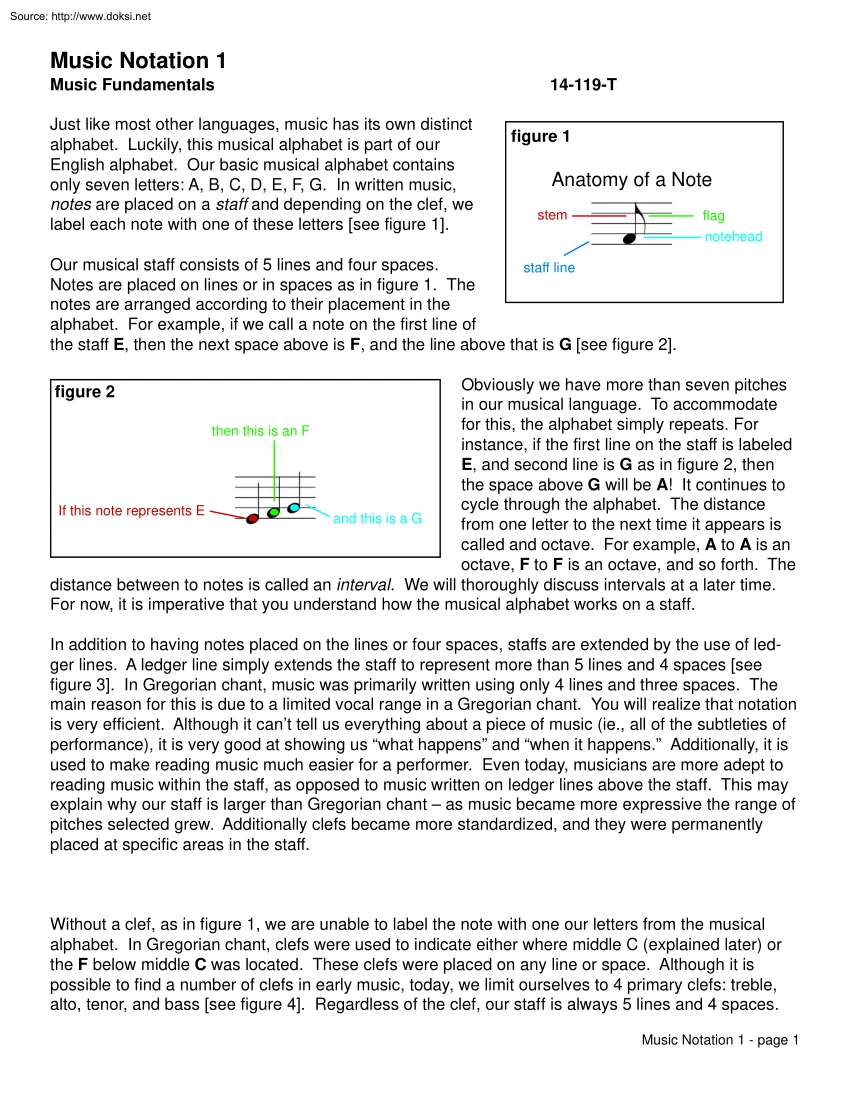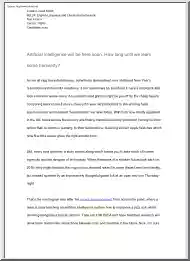Please log in to read this in our online viewer!

Please log in to read this in our online viewer!
No comments yet. You can be the first!
What did others read after this?
Content extract
Source: http://www.doksinet Music Notation 1 Music Fundamentals Just like most other languages, music has its own distinct alphabet. Luckily, this musical alphabet is part of our English alphabet. Our basic musical alphabet contains only seven letters: A, B, C, D, E, F, G. In written music, notes are placed on a staff and depending on the clef, we label each note with one of these letters [see figure 1]. 14-119-T figure 1 Anatomy of a Note stem flag notehead Our musical staff consists of 5 lines and four spaces. staff line Notes are placed on lines or in spaces as in figure 1. The notes are arranged according to their placement in the alphabet. For example, if we call a note on the first line of the staff E, then the next space above is F, and the line above that is G [see figure 2]. Obviously we have more than seven pitches in our musical language. To accommodate for this, the alphabet simply repeats. For then this is an F instance, if the first line on the staff is labeled E,
and second line is G as in figure 2, then the space above G will be A! It continues to cycle through the alphabet. The distance If this note represents E and this is a G from one letter to the next time it appears is called and octave. For example, A to A is an octave, F to F is an octave, and so forth. The distance between to notes is called an interval. We will thoroughly discuss intervals at a later time For now, it is imperative that you understand how the musical alphabet works on a staff. figure 2 In addition to having notes placed on the lines or four spaces, staffs are extended by the use of ledger lines. A ledger line simply extends the staff to represent more than 5 lines and 4 spaces [see figure 3]. In Gregorian chant, music was primarily written using only 4 lines and three spaces The main reason for this is due to a limited vocal range in a Gregorian chant. You will realize that notation is very efficient. Although it can’t tell us everything about a piece of music (ie,
all of the subtleties of performance), it is very good at showing us “what happens” and “when it happens.” Additionally, it is used to make reading music much easier for a performer. Even today, musicians are more adept to reading music within the staff, as opposed to music written on ledger lines above the staff. This may explain why our staff is larger than Gregorian chant – as music became more expressive the range of pitches selected grew. Additionally clefs became more standardized, and they were permanently placed at specific areas in the staff. Without a clef, as in figure 1, we are unable to label the note with one our letters from the musical alphabet. In Gregorian chant, clefs were used to indicate either where middle C (explained later) or the F below middle C was located. These clefs were placed on any line or space Although it is possible to find a number of clefs in early music, today, we limit ourselves to 4 primary clefs: treble, alto, tenor, and bass [see
figure 4]. Regardless of the clef, our staff is always 5 lines and 4 spaces Music Notation 1 - page 1 Source: http://www.doksinet The clefs we will deal with in this lecture are the treble and bass clefs [see figure 5]. These clefs evolved then this note is a C from letters of the alphabet. The treble and this is a D clef comes from the letter G. The line and this is an E that runs through the circle of this clef is the G above middle C or G4. The If this note represents B bass clef evolved from the letter F. The line of the staff that runs between the two dots of the bass clef is the F below middle C. With this ledger lines knowledge, we can figure out any other note in the staff simply by counting up or down from these points of reference. For example, the top space of the staff with the bass clef is G3 – it comes after F in our alphabet (we will address what the numbers indicate in the next lesson). See, this is figure 4 simple! figure 3 At this point, you can start working
with the first notation Treble Clef Tenor Clef module located in the “labs” section of the course. Begin by clicking on the “Treble Clef” button and then work with the “Bass Clef”. At first it will probably take you a little time to recognize the note preAlto Clef Bass Clef sented; however, with pracfigure 5 tice your speed will inevitably improve. Do not neglect G above “middle C” working with the bass clef. You will most likely have the most trouble when presented with a note on ledger lines. I will address ledger lines more thoroughly in the next lecture. You should spend at least 30 minutes a day working with this module to increase your proficiency. Feel free to email me your progress at anytime; however, keep checking the “assignments” section for any particular deadlines. Happy reading! F below “middle C” Music Notation 1 - page 2
and second line is G as in figure 2, then the space above G will be A! It continues to cycle through the alphabet. The distance If this note represents E and this is a G from one letter to the next time it appears is called and octave. For example, A to A is an octave, F to F is an octave, and so forth. The distance between to notes is called an interval. We will thoroughly discuss intervals at a later time For now, it is imperative that you understand how the musical alphabet works on a staff. figure 2 In addition to having notes placed on the lines or four spaces, staffs are extended by the use of ledger lines. A ledger line simply extends the staff to represent more than 5 lines and 4 spaces [see figure 3]. In Gregorian chant, music was primarily written using only 4 lines and three spaces The main reason for this is due to a limited vocal range in a Gregorian chant. You will realize that notation is very efficient. Although it can’t tell us everything about a piece of music (ie,
all of the subtleties of performance), it is very good at showing us “what happens” and “when it happens.” Additionally, it is used to make reading music much easier for a performer. Even today, musicians are more adept to reading music within the staff, as opposed to music written on ledger lines above the staff. This may explain why our staff is larger than Gregorian chant – as music became more expressive the range of pitches selected grew. Additionally clefs became more standardized, and they were permanently placed at specific areas in the staff. Without a clef, as in figure 1, we are unable to label the note with one our letters from the musical alphabet. In Gregorian chant, clefs were used to indicate either where middle C (explained later) or the F below middle C was located. These clefs were placed on any line or space Although it is possible to find a number of clefs in early music, today, we limit ourselves to 4 primary clefs: treble, alto, tenor, and bass [see
figure 4]. Regardless of the clef, our staff is always 5 lines and 4 spaces Music Notation 1 - page 1 Source: http://www.doksinet The clefs we will deal with in this lecture are the treble and bass clefs [see figure 5]. These clefs evolved then this note is a C from letters of the alphabet. The treble and this is a D clef comes from the letter G. The line and this is an E that runs through the circle of this clef is the G above middle C or G4. The If this note represents B bass clef evolved from the letter F. The line of the staff that runs between the two dots of the bass clef is the F below middle C. With this ledger lines knowledge, we can figure out any other note in the staff simply by counting up or down from these points of reference. For example, the top space of the staff with the bass clef is G3 – it comes after F in our alphabet (we will address what the numbers indicate in the next lesson). See, this is figure 4 simple! figure 3 At this point, you can start working
with the first notation Treble Clef Tenor Clef module located in the “labs” section of the course. Begin by clicking on the “Treble Clef” button and then work with the “Bass Clef”. At first it will probably take you a little time to recognize the note preAlto Clef Bass Clef sented; however, with pracfigure 5 tice your speed will inevitably improve. Do not neglect G above “middle C” working with the bass clef. You will most likely have the most trouble when presented with a note on ledger lines. I will address ledger lines more thoroughly in the next lecture. You should spend at least 30 minutes a day working with this module to increase your proficiency. Feel free to email me your progress at anytime; however, keep checking the “assignments” section for any particular deadlines. Happy reading! F below “middle C” Music Notation 1 - page 2




